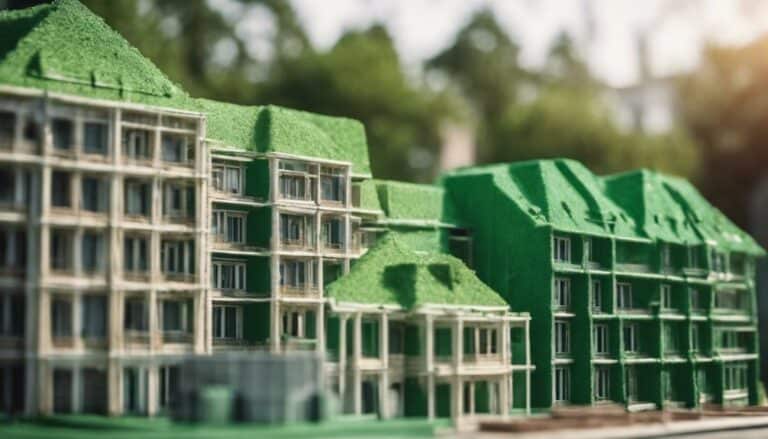When it comes to the economics of green building materials, you might find yourself questioning whether the initial costs are truly worth the long-term benefits. However, before making a decision, consider the implications of sustainability on your bottom line. The savings and advantages associated with green materials extend far beyond the upfront expenses. So, before dismissing the idea, take a moment to ponder how incorporating eco-friendly elements into your construction plans could transform your financial outlook in ways you may not have considered.
Key Takeaways
- Green building materials offer a payback period of 3-5 years.
- Energy-efficient materials reduce operating costs by up to 20%.
- Green buildings can yield returns of up to 40% over their lifetime.
- Health benefits include improved indoor air quality and occupant well-being.
- Tax incentives and higher resale values come with using green materials.
Energy Efficiency Benefits
Utilizing green building materials for energy efficiency purposes can substantially reduce operational costs and utility expenses through a significant decrease in energy consumption. Green building materials have the capability to lower energy consumption by 25-50% compared to traditional materials. This reduction directly translates into lower utility bills and operational costs for building owners.
Additionally, sustainable construction practices involving energy-efficient designs with green materials offer a reasonably short payback period of 3-5 years, making it a financially sound investment. The durability of green materials further contributes to cost savings, with green buildings experiencing about a 12% decrease in maintenance costs.
Furthermore, the return on investment (ROI) for implementing energy-efficient green building materials can be as high as 40% over the building's lifetime. This data underscores the economic benefits and long-term advantages of incorporating green building materials for energy efficiency in construction projects.
Cost Savings Over Time
Cost savings over time with green building materials can be substantial, with the potential for up to a 20% reduction in operating costs throughout the lifespan of a building. By incorporating energy-efficient materials, utility bills and maintenance expenses can be greatly lowered.
Sustainable construction practices also play an important role in reducing long-term maintenance costs by around 12%. The return on investment (ROI) for green buildings is impressive, with potential returns of up to 40% over their lifetime. Green buildings typically have a payback period of 3-5 years, showcasing their cost-saving benefits.
These financial advantages make investing in green building materials a strategic choice for long-term savings and efficiency. As you consider the economics of construction, factoring in the lower operating costs, reduced maintenance expenses, and quicker payback periods associated with green buildings can lead to a more financially sustainable and environmentally friendly choice for your projects.
Health and Well-being Impact
Shifting the focus from cost savings to the impact on health and well-being, green buildings have been shown to greatly enhance occupants' overall quality of life by promoting clean air and water within the indoor environment. Green-certified buildings play a vital role in ensuring the health and well-being of occupants by reducing exposure to toxins and enhancing occupant comfort.
This emphasis on health not only benefits individuals but also has broader implications for public health. Employees working in green-certified buildings experience 30% fewer sickness-related absences, leading to increased productivity and creating a healthier work environment overall.
Prioritizing health in green buildings not only saves costs by mitigating health issues but also contributes to improved well-being. By focusing on providing a healthier indoor environment, green buildings can positively impact the lives of occupants and the efficiency of the spaces they occupy.
Increased Property Value
Green buildings with sustainable features demonstrate a clear correlation with increased property value in the real estate market. Sustainable properties have higher resale values, with green-certified homes selling for 9% more than non-certified ones. Incorporating energy-efficient features enhances property marketability, attracting buyers seeking modern amenities.
By including sustainable and eco-friendly elements in property design and construction, resale value is further boosted. Investing in green buildings offers long-term financial benefits, with a potential ROI of up to 40% over the building's lifetime. The payback period for green buildings typically ranges from 3 to 5 years, showcasing the economic advantages of such investments.
Understanding the economic advantages of green buildings can help you make informed decisions about property investments, considering not just the immediate costs but also the long-term benefits that sustainable features can bring to property value.
Tax Incentives and Marketability
Essentially, the utilization of green building materials can result in significant financial benefits through tax incentives and enhanced marketability in the real estate sector. Tax incentives, such as deductions, credits, or rebates, are available at federal, state, and local levels to offset the costs associated with incorporating sustainable materials.
Properties constructed with green building materials not only contribute to environmental benefits but also cater to the increasing consumer demand for eco-friendly features. The marketability of these properties is further bolstered by certifications like LEED, which not only enhance property value but also attract environmentally-conscious buyers.
Essentially, the use of green building materials goes beyond sustainability; it presents a strategic financial advantage by tapping into tax incentives and improving marketability. As the real estate market continues to prioritize eco-conscious choices, properties with eco-friendly features are positioned to reap the rewards of both tax incentives and heightened market desirability.
Conclusion
You've seen the numbers and heard the success stories. Investing in green building materials isn't just a trend, it's a smart financial decision.
Like planting a tree that grows stronger and more valuable over time, choosing sustainability in construction can lead to long-term benefits that far outweigh the initial costs.
So, next time you're faced with a building project, remember: going green isn't only good for the environment, but also for your wallet.

